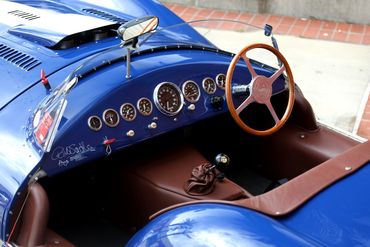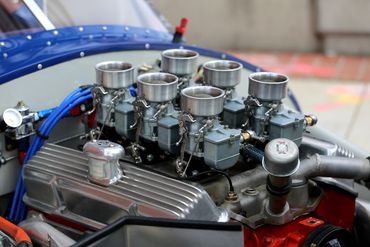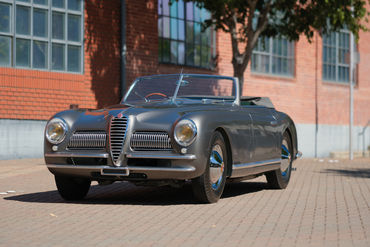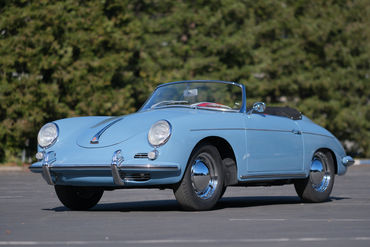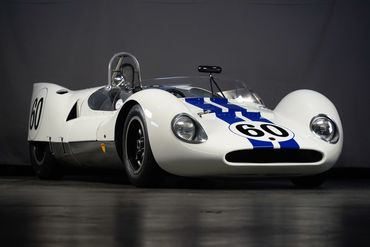Sold
SOLD 10/20
1959 Sadler-Meyer
Special
Three Time Giant's Despair Hillclimb Champion and Unlimited Class Record Holder.
- VINSC008
- Exterior ColorBlue
- Interior ColorBrown Leather
- Mileage5 Miles (TMU)
- Engine283 Chevrolet Small Block Bored to 339 c.i.
- Engine no.3756519
- TransmissionBorg-Warner T10 4-Speed
- StatusSold
- StockFJ1243
Description
1959 Sadler-Meyer Special
s/n SC008, Engine No. 3756519
Blue with Brown Leather
The 1959 Sadler-Meyer Special is a remarkable automobile on many criteria. Its history is traceable to the earliest days of America’s road racing history in pre-war ARCA events. It won and set records at one of North America’s earliest and most storied competitions, the Giant’s Despair Hillclimb. It was engineered and constructed by Bill Sadler, a multiple talent who designed, constructed and drove his road racing specials in competition with legends like Scarab, Lister-Corvette, Maserati, Ferrari and Chaparral, and was reliably fast, if not a reliable finisher.
Giant’s Despair got its start when the Matheson Motor Car Company relocated to Wilkes-Barre. Matheson’s chief engineer Charles Greuter, who later would engineer the famed “Safety” Stutz, tested Matheson’s 24 and 40hp fours on the quarter mile long 22 ½ % grade of Laurel Run’s Northhampton Street. It was a punishing test of pulling power that far exceeded Pike’s Peak maximum grade of 10 ½ % and even the 22% of Mt. Washington’s final 50 yards.
Other manufacturers realized the value, in both testing and publicity, of Giant’s Despair. Their activities brought competition to the hill in 1906 and since then it has tested the skill of drivers like Barney Oldfield, Ralph dePalma, Louis Chevrolet, Phil Walters, Roger Penske and Carroll Shelby among countless others.
In 1951 Giant’s Despair was revived by the nascent Sports Car Club of America, beginning a renaissance that has continued to the present, with times that dropped to under a minute in 1956 with Carroll Shelby’s run in a GP Ferrari. Among the participants in the rebirth of Giant’s Despair was John van Meyer.
Van Meyer owned a road race special built for the Northeast’s prewar ARCA road races and campaigned the cycle-fendered car in early SCCA races and hillclimbs with a variety of increasingly powerful engines. The earliest Ford flathead V-8 was supplanted by a Cadillac and then a Pontiac, always chasing what Brock Yates described in a December 8, 1962 Competition Press feature as: “Cubes. That’s what successful hill climb cars need. And that’s what John Meyer’s Giant’s Despair record holder has …”
Meyer and the rail-frame special won the 1957 New York State Hillclimb Championship and placed well on the Northeast’s road courses. But it was soon overwhelmed by the “cubes” and talents of Detroit’s OEMs and the tuners who unlocked the potential of their big V-8s.
In 1958 Meyer brought the car to Canadian engineer and race car constructor Bill Sadler with the request to rebuild his Meyer Special into a contemporary road race and hillclimb competitor. Bill Sadler was a gifted car builder who combined the design instinct of Colin Chapman and the mechanical skills of Phil Remington with no small amount of instinctive driving talent. Brought up in his father’s ship in St. Catherine’s, Ontario, a center of regional race preparation, Bill got the racing bug in earnest while visiting England on his honeymoon and returned to St. Catherine’s to begin a career that would culminate in his construction of a series of Sadler sports racing cars that challenged the greatest North American road racers of the day, competing head-to-head with Scarabs, Ferraris and Listers, frequently showing them the Sadlers’ taillights.
The Chevrolet-powered ladder frame Sadler Mk 2 employed simple yet imaginative features including a swing axle independent rear suspension and an ENV pre-selector gearbox. A year’s experience racing in England while working with John Tojeiro brought Sadler more experience. The 100 GBP he won for fastest speed of the meet at the Brighton Speed Trials bought the Mk 2 and succeeded in capturing an overall win at the Watkins Glen Classic. Sadler then caught the eye of parts distributor Earl Nisonger (KLG spark plugs, among others) who funded construction of the Sadler Mk 3. It was a space frame car running a 327 cubic inch Hilborn fuel injected Chevy, with independent suspension that vied with the best in the world.
The Sadler-Meyer Special and Sadler Mk 3 marked a turning point in Bill Sadler’s career. He went on to create a variety of vehicles through 1961, from the Mk 4 and Mk 5 sports-racers to go karts, Formula 3 and Formula Libre race cars, each of them containing some unique design feature or component. Sadler then left racing to turn his attention to a fledgling business career. Still an innovator, today Bill Sadler builds lightweight aircraft in Scottsdale, Arizona.
Bill Sadler constructed a simple ladder frame for the Sadler-Meyer Special, retaining the original Meyer Special’s Pontiac V-8, Borrani wire wheels and deDion rear suspension. The aluminum body is in the style of contemporary sports racing cars but built to accommodate Meyer’s 6’4” 250 pound frame and the big Pontiac engine. A huge hood-top air scoop covered the Pontiac’s carburetor and the air filter necessitated by frequently unpaved hillclimb surfaces. The body’s design is as attractive as Bill Sadler’s engineering, with shapely fenders, a tightly rounded cowl, low radiator air intake, driver’s head fairing and full width Plexiglas windshield that is barely as high as the tops of the front fenders. Its appearance is as good as the best late 1950s road racers, and so was its performance, capturing Meyer’s second New York State Hillclimb Championship in 1959 and scoring a second place finish at Thompson Speedway in Connecticut on July 19, 1959.
In 1960, 1961, and 1962 Meyer set fast time of the day and new course records at Giant’s Despair while also circuit racing at Thompson, Lime Rock and Bridgehampton. Confirmed classifications include a second overall and first in B/Modified at Thompson on October 9, 1960, fifth overall at Lime Rock two weeks later and third in C/Modified at Thompson in July 1962.
Some time thereafter Meyer sold the Sadler-Meyer Special (a conclusion gleaned from his FTD and Giant’s Despair in 1967 in a Cooper-Ford and in 1968 and 1970 in a Lola T70) and it dropped from sight. It was apparently restored and historic raced in the 1980s by Robert Fernano. It was restored again in 2008 for the previous owner, with input and assistance from Bill Sadler, to its present sharp and race-ready condition. At some time during its post-Bill Sadler history, the side exhaust pipes were enclosed, Plexiglas side windows were added for the occupants’ comfort and the nose was extended and entry lowered over a re-shaped radiator air intake, probably for better air penetration and a bit of front aerodynamic downforce. The prominent hood scoop has been replaced by a slight bubble over the engine air intake, not only improving the driver’s visibility but also the car’s appearance. It still retains its great Sadler looks however, and its undeniable link with its siblings from St. Catherine’s.
Following its most recent restoration it participated in the Colorado Grand and then was publicly displayed at the 2009 Greenwich Concours d’Elegance. It has not been raced since restoration but is prepared to modern historic competition sanctioning bodies’ safety standards including onboard fire suppression system, fuel cell and electrical shutoff. It also is equipped with road and touring equipment including turn signals.
The driveline is a ’58-’62 283 Chevrolet small block bored and stroked to 339 cubic inches with camel hump heads and an Offenhauser intake manifold, with a sextet of Stromberg 97 carburetors, dynode at 425hp at 6,000 rpm and 372 lm-ft torque. A Borg-Warner T10 4-speed transmission and Halibrand quick change center section help put that power to the pavement. Suspension is coilover sprung independent at the front with deDion rear with Panhard bar, Jacob’s ladder torque arm and inboard-mounted aluminum drum brakes. Front brakes are solid motor discs behind Halibrand centerlock alloy wheels. The Sadler bodywork opens completely for quick access and service with the nose folding forward and the tail folding back.
In 2015 Fantasy Junction had the opportunity to sell the Sadler-Meyer Special to a collector and motorsports enthusiast in Europe who participated to two track days with the car, but performed considerable mechanical and some cosmetic work under his ownership to ensure that the car was in absolute top order both on the track and while in the paddock. This work included a complete re-upholstery of the interior, but also: a complete new pedal box assembly, new brake and clutch hydraulics, new brake proportioning valve, relocation and replacement of the brake and fuel lines, new tachometer and speedometer units, new starter, battery, and improved wiring, a major engine inspection and service, and installation of a new carburetor and linkage. Importantly, the wheels were crack tested, and the wheel bearings replaced. And finally, the differential was restored, to ensure that the power of the 283ci Chevy was transferred to the racing surface without error.
The Sadler-Meyer Special might well be known as The King of the Hill. With John van Meyer behind the wheel it set fast time of the day for three consecutive years – each of them breaking the Unlimited Class record – at one of America’s oldest and most famous hillclimbs, Giant’s Despair in Laurel Run Borough, Pennsylvania.
Meticulously restored in deep blue livery with red leather upholstered seats, the Sadler-Meyer Special will be a welcome entrant in road tours, Concours and historic racing events where its history, performance and good looks will set it apart both in motion and on display.
At Giant’s Despair it will be the star of the show, and still capable of thrilling the crowd with a fast time, just like John van Meyer put in 1960.
The above vehicle information is complete and accurate to the best of our knowledge at the time it is posted to this website. Corrections or additional information is always appreciated. All advertised prices exclude government fees and taxes, any finance charges, any dealer document preparation charge, and any emission testing charge. Vehicles are subject to prior sale. All advertised to be true but not guaranteed. We assume no liability for errors or omissions.
Inquire About This Car
Fantasy Junction • 510-653-7555 • 1145 Park Ave, Emeryville, CA 94608

